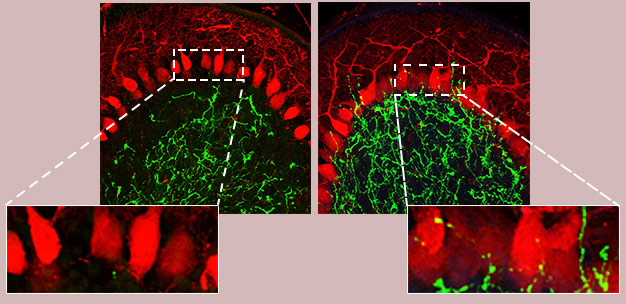Two roles are performed by one protein to ensure the correct wiring of brain networks
Published online 6 March 2015

Sections of the cerebellum in mice show that when the cell-surface protein Cadherin-7 (Cdh7) is expressed (left), pontine nucleus (PN) neurons (green) do not connect to Purkinje cells (red). However, reducing levels of Cdh7 in PN neurons (right) causes abundant connection of PN axons to Purkinje cells.
Reproduced from Ref. 1 and licensed under CC BY-NC-ND 3.0 © K. Kuwako et al.
A single cell-surface protein is crucial for precise wiring of a specific brain network, according to work by Keio University researchers1. The discovery might reveal a general mechanism by which a family of proteins controls development of the nervous system.
During development, neurons extend projections called axons, which make connections called synapses with other neurons to build specialized neural networks. For accurate wiring of these networks, axons must stop growing when they reach the right place and form synapses with the correct neurons. To identify the molecular mechanisms underlying this process, Ken-ichiro Kuwako from Keio University School of Medicine and colleagues focused on an area of the brain called the cerebellum.
"The cerebellum is an excellent model for studying circuit connectivity because it has a well-characterized simple structure that consists of a small number of neuronal cell types," explains Kuwako.
Previous studies showed that two of these cell types ― mossy fiber neurons and climbing fiber neurons ― make different connections during development. Kuwako and colleagues aimed to determine which molecules underlie these differences by analyzing the proteins expressed in the two cell types at specific developmental stages
"This in vivo screening was a time-consuming step," says Kuwako. "It took us almost a year to complete." But the team's patience paid off: they showed that Cadherin-7 (Cdh7) ― a cell-surface protein that mediates interactions between cells by binding to itself ― is expressed at the developing synapses of mossy fiber neurons but not of climbing fiber neurons. They also discovered Cdh7 expression in the neurons with which mossy fiber neurons form specific synapses.
To examine how Cdh7 affects axon growth, the researchers grew a type of mossy fiber neurons called pontine nucleus (PN) neurons alongside cells that either did or did not express Cdh7. They observed reduced axon growth when PN neurons were surrounded by Cdh7-expressing cells, indicating that interactions between Cdh7 molecules on the two types of cells impede axon growth.
Cdh7 also proved important for the formation of specific synapses. In mice, reduced Cdh7 expression in PN neurons led to the formation of fewer synapses with granule cells, which are normally specific targets, and more with Purkinje cells, which are not (see image).
"This study provides the first evidence that a single bi-functional cell-surface receptor orchestrates precise wiring by regulating axonal growth termination and synaptic specificity," says Kuwako. "Over 100 members of the same protein superfamily are expressed in a circuit-specific manner and may also play a dual role to establish precise wiring."
Reference
- Kuwako, K., Nishimoto, Y., Kawase, S., Okano, H. J. & Okano, H. Cadherin-7 regulates mossy fiber connectivity in the cerebellum. Cell Reports 9, 311-323 (2014). | article